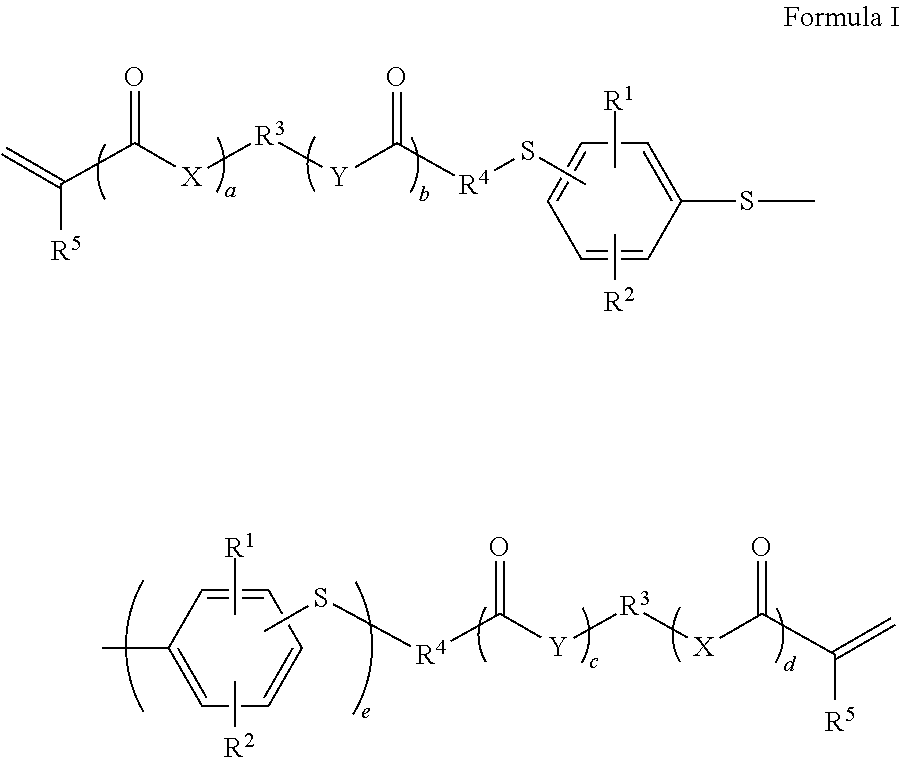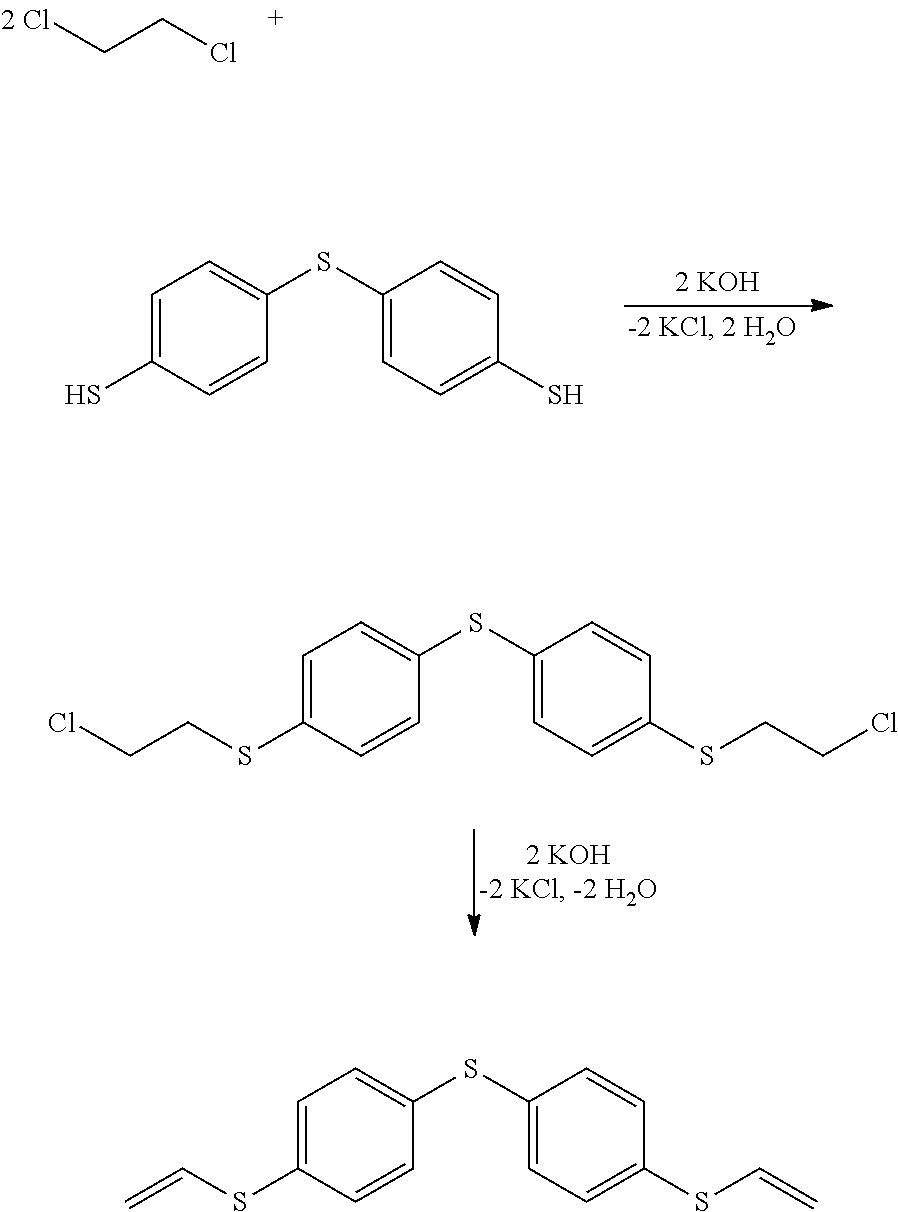Dental materials based on low-viscosity radically polymerizable monomers with a high refractive index
a technology of low viscosity and radically polymerization, applied in dental prosthetics, dental preparations, impression caps, etc., can solve the problems of reduced refractive index of resin mixture, reduced ideal values, and high cost, and achieve low polymerization shrinkage and great curing depth
- Summary
- Abstract
- Description
- Claims
- Application Information
AI Technical Summary
Benefits of technology
Problems solved by technology
Method used
Image
Examples
example 1
Synthesis of bis(4-vinylthiophenyl)sulfide
[0091]
[0092]To synthesize bis(4-vinylthiophenyl)sulfide, 4,4′-thiobis(benzenethiol) was first reacted with an excess of 1,2-dichloroethane in the presence of KOH and tetrabutylammonium chloride at room temperature (23° C.). The bis[4-(2-chloroethylthiophenyl)sulfide obtained was dehydrohalogenated with KOH in water at 85° C. to form bis(4-vinylthiophenyl)sulfide. Bis(4-vinylthiophenyl)sulfide was obtained as a colourless, low-viscosity liquid at room temperature, with a viscosity η of only 17 mPa s (23° C.). The refractive index nD is 1.695 and the polymerization shrinkage ΔPV is −7.8 vol.-%. The polymerization shrinkage was measured in accordance with DIN 13907: “Dentistry: Polymerization shrinkage of filling materials”.
example 2
Monomer Mixtures with a Monomer According to the Invention
[0093]Starting from bis(4-vinylthiophenyl)sulfide and the frequently used dental diluent monomer triethylene glycol dimethacrylate (TEGDMA), various monomer mixtures were prepared and their refractive indices were determined (Table 1). The properties of TEGDMA are: η=10 mPa s (23° C.), nD=1.461 and ΔP V=−14.3 vol.-%.
[0094]The results in Table 1 demonstrate that the monomer according to the invention is very suitable for the preparation of mixtures with a much higher refractive index starting from usual dental diluent monomers which exhibit a low refractive index.
[0095]
TABLE 1Refractive indices of mixtures of bis(4-vinylthiophenyl)sulfide and TEGDMAMonomer mixture [wt.-% / wt.-%]Refractive indexTEGDMA1.461Bis(4-vinylthiophenyl)sulfide / TEGDMA: 10:901.482Bis(4-vinylthiophenyl)sulfide / TEGDMA: 20:801.504Bis(4-vinylthiophenyl)sulfide / TEGDMA: 40:601.548Bis(4-vinylthiophenyl)sulfide / TEGDMA: 50:501.572Bis(4-vinylthiophenyl)sulfide1.695
example 3
Light-Curing Resin
[0096]To prepare a light-curing resin, 5.0 g bis(4-vinylthiophenyl)sulfide was mixed with 4.95 g TEGDMA and the photoinitiator Ivocerin® (bis(4-methoxybenzoyl)diethylgermanium (Ivoclar Vivadent AG), 50 mg). From the mixture, test pieces were prepared which were irradiated for 3 minutes twice with a dental light source (Spectramat®, Ivoclar Vivadent AG) and thereby cured. In accordance with the ISO standard ISO-4049 (Dentistry—Polymer-based filling, restorative and luting materials), the flexural strength (FS) and the flexural modulus (FM) were determined after 24 h of storage of the test pieces at room temperature (RT) or after 24 h or 1 week (7 d) of storage in water at 37° C. (WS) (Table 2):
[0097]
TABLE 2Mechanical properties of a mixture of bis(4-vinylthiophenyl)sulfideand TEGDMA after light curing24 h RT24 h WS7 d WSFS (MPa)82.4 ± 10.396.9 ± 13.378.6 ± 9.0 FM (GPa)2.36 ± 0.212.62 ± 0.192.71 ± 0.15
[0098]The results of the mechanical investigations in Table 2 show...
PUM
| Property | Measurement | Unit |
|---|---|---|
| temperature | aaaaa | aaaaa |
| refractive index | aaaaa | aaaaa |
| refractive index | aaaaa | aaaaa |
Abstract
Description
Claims
Application Information
 Login to View More
Login to View More - R&D
- Intellectual Property
- Life Sciences
- Materials
- Tech Scout
- Unparalleled Data Quality
- Higher Quality Content
- 60% Fewer Hallucinations
Browse by: Latest US Patents, China's latest patents, Technical Efficacy Thesaurus, Application Domain, Technology Topic, Popular Technical Reports.
© 2025 PatSnap. All rights reserved.Legal|Privacy policy|Modern Slavery Act Transparency Statement|Sitemap|About US| Contact US: help@patsnap.com



